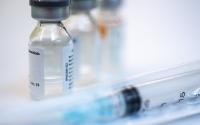[ad_1]
Acute allergic reactions occurred in 2.10% but anaphylaxis in only 0.025% of employees of two Boston hospitals who received their first dose of the Pfizer-BioNTech or Moderna COVID-19 vaccine, according to a research letter published yesterday in JAMA.
Scientists from Massachusetts General Hospital and Brigham and Women’s Hospital administered email, text, phone, and smartphone app survey links to 64,900 employees who received a dose of one of the two mRNA coronavirus vaccines from Dec 16, 2020, to Feb 12, 2021.
mRNA vaccines “teach” human cells to make a harmless part of the SARS-CoV-2 spike protein to trigger an immune response to the virus. The authors noted that people with a history of life-threatening reactions, or anaphylaxis, to allergens such as those in a vaccine are often hesitant to receive vaccines, which may complicate efforts to end the pandemic.
A total of 25,929 employees (40%) received the Pfizer vaccine, while 38,971 (60%) received the Moderna vaccine. Eighty-one percent returned at least one symptom survey, which were sent each day for 3 days after vaccination.
Among all vaccinated employees, 1,365 (2.10%) reported acute allergic reactions, defined on the survey as itching, rash, hives, swelling, and/or respiratory symptoms. More Moderna vaccinees (2.20%) reported symptoms than Pfizer vaccinees (1.95%).
Previous anaphylactic episodes
A review of medical records identified anaphylaxis in 16 workers (0.025%) (9 [0.023%] with the Moderna vaccine and 7 [0.027%] with the Pfizer vaccine). Mean age of vaccinees diagnosed as having anaphylaxis was 41 years, 94% were women, 63% had a history of allergy, and 31% had previously had anaphylaxis.
Mean time from vaccination to anaphylaxis onset was 17 minutes. One patient required intensive care, 56% received intramuscular epinephrine (to facilitate breathing), and all recovered without experiencing shock or requiring endotracheal intubation. Three workers with a history of anaphylaxis didn’t seek medical care. The mechanism of the anaphylaxis occurrences in the study is unknown.
The Centers for Disease Control and Prevention previously reported an incidence of anaphylaxis of 2.5 to 11.1 per million doses, most of them in people with a history of allergy, the authors noted.
“The incidence rate of confirmed anaphylaxis in this study is larger than that reported by the Centers for Disease Control and Prevention based on passive spontaneous reporting methods,” they wrote. “However, the overall risk of anaphylaxis to an mRNA COVID-19 vaccine remains extremely low and largely comparable to other common health care exposures.”
While most vaccinees with anaphylaxis had a history of allergy, the researchers noted that because about 5% of US adults have severe food allergies, and 1% have severe drug allergies, the employee group studied must have included nearly 4,000 workers with histories of anaphylaxis who were vaccinated without related adverse events.
“In this prospective cohort of health care employees, 98% did not have any symptoms of an allergic reaction after receiving an mRNA COVID-19 vaccine,” the authors wrote.
[ad_2]
Source link












